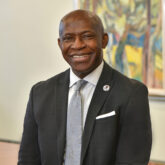
Ermine Calandra Cunningham ’73
I was trying to lie low in my dorm room after the raucous lunchtime incident. There was nobody I could talk to about it, either; the other girls spoke little English, and my Spanish wasn’t good enough yet to describe what had happened.
It was Friday afternoon and classes were finished for the week. My roommates were waiting downstairs in La Residencia, the three-story girls’ dorm at the University of Puerto Rico, for a ride home. All but a few of the girls went home every weekend to visit their families and novios (sweethearts). It would be a ghost town by five o’clock. The long halls were dark; the rare echoing footsteps made me feel abandoned.
Earlier, after my last class, I had changed into my funky, worn-out jeans from home. A small red bandana patch was sewn on the lower part of the butt area where they’d ripped. I ambled over to the main cafeteria and went through the food line; as I reached the register, some boys on the balcony began pointing and shouting, but the only words I understood were, rojo (red) and Mira! Mira! (Look! Look!)
It dawned on me then that my patch was sending out some kind of hussy signal. My ribs squeezed in panic; my face must have matched the shade of the bandana patch. I pretended I didn’t see or hear them, ate by myself and slipped out when I was sure they’d left.
That was in 1970, but it may as well have been the 1870s in San Juan. Young women on campus wore dresses and skirts below the knee, coordinated with matching shoes and handbags. Conversely, my wardrobe consisted of: one high-necked granny dress, three pairs of jeans, a bunch of T-shirts, black and white striped elephant-leg bell-bottoms, sandals and white platform shoes (for the elephant bells). There had to have been a few daring Puerto Rican women who were beginning to experience the freedom of pants, but where were they? It felt strange to be around peers who dressed like June Cleaver.
Being an exchange student was not turning out so well for me. The other six Oswego students had refused to live in the dorms—too many rules—and ended up sharing apartments. They had a fabulous semester, but learned little Spanish; I stayed put and became somewhat fluent in Spanish—a huge asset in my life—but felt lonely and isolated much of the time. Looking back, I realize that this experience gave me the gift of understanding culture shock firsthand, and planted the seed for my perfect-fit career as an English as a second language teacher. But I still wish
I hadn’t sewn that patch on.
Ermine Calandra Cunningham ’73 taught special education preschool in Rochester, N.Y., and English as a second language in Syracuse, N.Y. After retiring in 2010, she completed a two-year creative nonfiction program at the Syracuse Writers Center. Her humorous short story Sometimes Dreams Do Come True was featured on the Erma Bombeck Writers Workshop website. She authored the book, Pretend You Know What You’re Doing: My Voyage from Teacher to Humor Writer (Create Space, 2014). Check out more of her work at http://ermigal.wordpress.com.
More from Last Word
The Last Word: Queer Eye for the Alumni
The Last Word: Queer Eye for the Alumni I am a queer alumnus (Class of '09!) who now teaches in the …
The Last Word
The Last Word Education Key to Creating Change Life is about the possibilities and obstacles. It’s what you do with the two …
The Last Word: Memories of My Alma Mater and My Mentor
The Last Word: Memories of My Alma Mater and My Mentor How does time race by all of us so quickly? …











